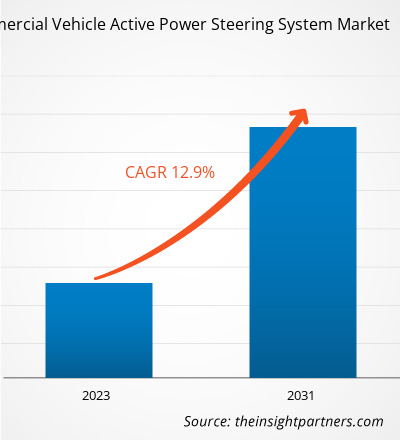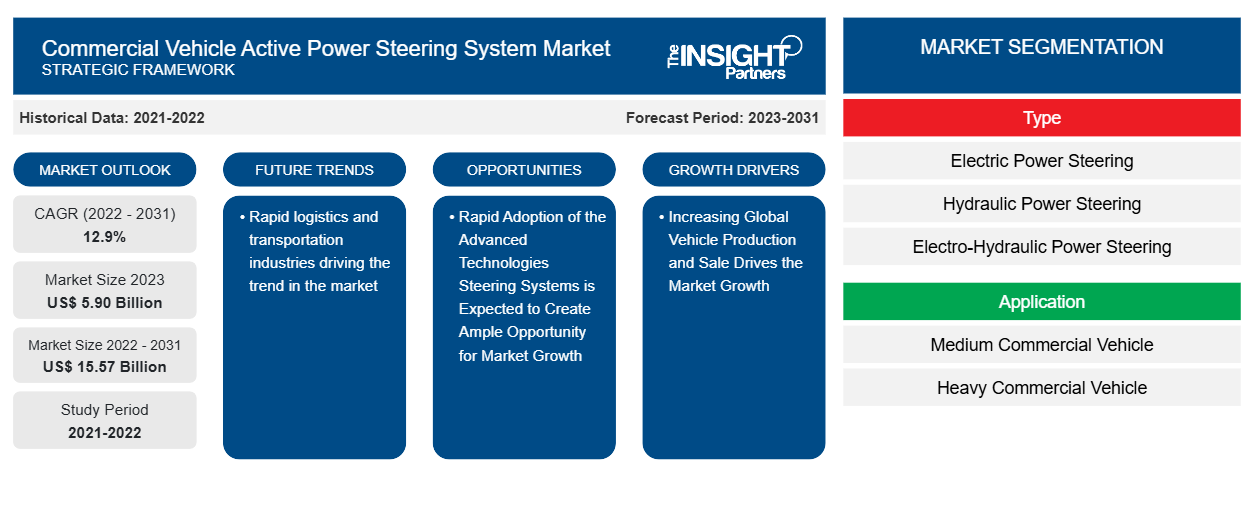Der Markt für aktive Servolenkungen für Nutzfahrzeuge soll von 5,90 Milliarden US-Dollar im Jahr 2023 auf 15,57 Milliarden US-Dollar im Jahr 2031 anwachsen. Der Markt soll in den Jahren 2022–2031 eine durchschnittliche jährliche Wachstumsrate (CAGR) von 12,9 % verzeichnen. Die Nachfrage nach elektrischen Servolenkungen wächst rasant, da sie im Vergleich zu anderen herkömmlichen Lenksystemen für Nutzfahrzeuge effizienter sind und weniger Wartungskosten verursachen. Diese elektrischen Servolenkungen werden schnell in schweren und mittelschweren Nutzfahrzeugen eingesetzt. Steigende Nutzfahrzeugverkäufe auf der ganzen Welt sowie eine schnelle Industrialisierung und das Wachstum des Logistiksektors treiben das Wachstum des Marktes für aktive Servolenkungen für Nutzfahrzeuge im Prognosezeitraum voran.
Marktanalyse für aktive Servolenkungssysteme für Nutzfahrzeuge
Das aktive Servolenkungssystem für Nutzfahrzeuge wird durch das rasante Wachstum des Transport- und Logistiksektors aufgrund der zunehmenden Nutzung des Online-Shoppings unter den Verbrauchern vorangetrieben. Auch der Logistik- und Lagersektor in Entwicklungsländern wie Indien, China, Japan und anderen wächst. Ein Lager- und Logistiksektor ist für das Wachstum des aktiven Servolenkungssystems für Nutzfahrzeuge auf dem Markt von entscheidender Bedeutung. Laut der India Brand Equity Foundation Organization wurde der Lagermarkt in Indien im Jahr 2022 auf 34,99 Milliarden US-Dollar geschätzt und wächst im Prognosezeitraum 2022 bis 2027 mit einer durchschnittlichen jährlichen Wachstumsrate von 15,64 %.
Marktübersicht zu aktiven Servolenksystemen für Nutzfahrzeuge
Der weltweit steigende Absatz von Nutzfahrzeugen ist der wichtigste Wachstumsfaktor für den Markt für aktive Servolenkungssysteme. Laut der Internationalen Organisation der Kraftfahrzeughersteller erreichte der weltweite Absatz von Nutzfahrzeugen im Jahr 2022 24,22 Millionen Einheiten und wird bis 2023 auf rund 27,45 Millionen Einheiten steigen. Dieses rasante Wachstum bei Nutzfahrzeugen weltweit hat im Prognosezeitraum eine enorme Nachfrage nach dem Markt für aktive Servolenkungssysteme geschaffen.
Passen Sie diesen Bericht Ihren Anforderungen an
Sie erhalten kostenlose Anpassungen an jedem Bericht, einschließlich Teilen dieses Berichts oder einer Analyse auf Länderebene, eines Excel-Datenpakets sowie tolle Angebote und Rabatte für Start-ups und Universitäten.
- Holen Sie sich die wichtigsten Markttrends aus diesem Bericht.Dieses KOSTENLOSE Beispiel umfasst eine Datenanalyse von Markttrends bis hin zu Schätzungen und Prognosen.
Markttreiber und Chancen für aktive Servolenkungssysteme für Nutzfahrzeuge
Steigende weltweite Fahrzeugproduktion und -verkauf treiben das Marktwachstum an
Der weltweite Anstieg der Nutzfahrzeugverkäufe ist der wichtigste Antriebsfaktor für das Wachstum des Marktes für aktive Servolenkungssysteme für Nutzfahrzeuge. Weitere wichtige Wachstumstreiber des Marktes sind die wachsende Zahl staatlicher Vorschriften und Standards in Bezug auf kraftstoffsparende Technologien, die globale OEM-Bewegung zur Gewichtsreduzierung und Vereinfachung ihrer Autos sowie der Anstieg der Fahrzeugproduktion weltweit. Laut dem Bericht der Internationalen Organisation der Kraftfahrzeughersteller stiegen die weltweiten Fahrzeugverkäufe im Jahr 2023 im Vergleich zum Jahr 2022 von 82,87 Millionen auf rund 92,72 Millionen. Dieses schnelle Wachstum der Automobilproduktion weltweit hat eine enorme Nachfrage nach dem Wachstum des Marktes für aktive Servolenkungssysteme für Nutzfahrzeuge geschaffen.OEM movement to lighten and simplify their cars, and the rise in vehicle production around the globe. According to the International Organization of Motor Vehicle Manufacturers Report in 2023, global vehicle sales increased to around 92.72 million from 82.87 million compared to 2022. Such rapid growth in automotive production across the globe has created massive demand for the commercial vehicle active power steering system market growth.
Die schnelle Einführung der Lenksysteme mit fortschrittlichen Technologien dürfte reichlich Gelegenheit für Marktwachstum schaffen
Die hohen Wartungskosten von riemengetriebenen hydraulischen oder manuellen Lenksystemen führten zu einer enormen Nachfrage nach auf fortschrittlichen Technologien basierenden elektrischen Servolenkungen für Nutzfahrzeuge. Nutzfahrzeuge sind kraftstoffeffizient, reduzieren den CO2-Ausstoß um bis zu 7 g/km und sparen Kraftstoff beim Fahren von Nutzfahrzeugen. Mehrere wichtige Akteure auf dem Markt entwickeln weltweit Servolenkungen auf Basis fortschrittlicher Technologien. So hat Nexteer im August 2021 seine Produktionskapazität für Pinion Electric Steering (EPS)-Systeme auf den Markt gebracht und erweitert, um die Nachfrage nach Nutzfahrzeugen zu decken. Das neue Lenksystem wurde für Elektrofahrzeuge eingeführt, die eine höhere Leistung bieten, um schwerere Elektrofahrzeuglasten mit erstklassigen EPS-Spitzentechnologien für Schwerlastfahrzeuge zu lenken.Nexteer launched and expanded its production capacity of the pinion electric steering (EPS) systems to meet commercial vehicle demand. The new steering system was launched for electric vehicles that offer higher output to steer heavier electric vehicle loads with premium EPS advanced technologies for heavy-duty loading vehicles.
Segmentierungsanalyse des Marktberichts über aktive Servolenkungssysteme für Nutzfahrzeuge
Schlüsselsegmente, die zur Ableitung der Marktanalyse für aktive Servolenkungssysteme für Nutzfahrzeuge beigetragen haben, sind Typ, Anwendung und Geografie.
- Basierend auf dem Typ ist der globale Markt für aktive Servolenkungen für Nutzfahrzeuge in elektrische Servolenkungen (EPS), hydraulische Servolenkungen und elektrohydraulische Servolenkungen (EHPS) unterteilt. Unter diesen hat die elektrohydraulische Servolenkung im Jahr 2023 den größten Anteil.
- Basierend auf der Anwendung ist der Markt in mittlere Nutzfahrzeuge und schwere Nutzfahrzeuge unterteilt. Darunter haben schwere Nutzfahrzeuge im Jahr 2023 den größten Anteil, was auf steigende Umsätze der globalen Automobilproduktion und des weltweiten Automobilabsatzes zurückzuführen ist.
Marktanteilsanalyse für aktive Servolenkungssysteme für Nutzfahrzeuge nach geografischer Lage
Der geografische Umfang des Marktberichts über aktive Servolenkungssysteme für Nutzfahrzeuge ist hauptsächlich in fünf Regionen unterteilt: Nordamerika, Europa, Asien-Pazifik, Naher Osten und Afrika sowie Südamerika.
Der asiatisch-pazifische Raum hat im Jahr 2023 den größten Anteil am Markt für aktive Servolenkungssysteme für Nutzfahrzeuge. Unter diesen verzeichnen Indien und China aufgrund der steigenden Automobilproduktion und -verkäufe ein rasantes Wachstum. Die Präsenz mehrerer Hersteller mit zunehmender Verbreitung von EPS-Systemen in Indien und Japan treibt das Marktwachstum voran. Die zunehmende Installation des Marktes für elektrische Servolenkungssysteme treibt das Marktwachstum direkt an, da die Fahrzeugproduktion in den asiatisch-pazifischen Ländern zunimmt.
Regionale Einblicke in den Markt für aktive Servolenkungssysteme für Nutzfahrzeuge
Die regionalen Trends und Faktoren, die den Markt für aktive Servolenkungssysteme für Nutzfahrzeuge während des gesamten Prognosezeitraums beeinflussen, wurden von den Analysten von Insight Partners ausführlich erläutert. In diesem Abschnitt werden auch die Marktsegmente und die Geografie von aktiven Servolenkungsystemen für Nutzfahrzeuge in Nordamerika, Europa, im asiatisch-pazifischen Raum, im Nahen Osten und Afrika sowie in Süd- und Mittelamerika erörtert.

- Erhalten Sie regionale Daten zum Markt für aktive Servolenkungssysteme für Nutzfahrzeuge
Umfang des Marktberichts über aktive Servolenkungssysteme für Nutzfahrzeuge
| Berichtsattribut | Details |
|---|---|
| Marktgröße im Jahr 2023 | 5,90 Milliarden US-Dollar |
| Marktgröße bis 2031 | 15,57 Milliarden US-Dollar |
| Globale CAGR (2022 - 2031) | 12,9 % |
| Historische Daten | 2021-2022 |
| Prognosezeitraum | 2023–2031 |
| Abgedeckte Segmente | Nach Typ
|
| Abgedeckte Regionen und Länder | Nordamerika
|
| Marktführer und wichtige Unternehmensprofile |
|
Dichte der Marktteilnehmer für aktive Servolenkungssysteme für Nutzfahrzeuge: Auswirkungen auf die Geschäftsdynamik verstehen
Der Markt für aktive Servolenkungssysteme für Nutzfahrzeuge wächst rasant. Dies wird durch die steigende Nachfrage der Endnutzer aufgrund von Faktoren wie sich entwickelnden Verbraucherpräferenzen, technologischen Fortschritten und einem größeren Bewusstsein für die Vorteile des Produkts vorangetrieben. Mit der steigenden Nachfrage erweitern Unternehmen ihr Angebot, entwickeln Innovationen, um die Bedürfnisse der Verbraucher zu erfüllen, und nutzen neue Trends, was das Marktwachstum weiter ankurbelt.
Die Marktteilnehmerdichte bezieht sich auf die Verteilung der Firmen oder Unternehmen, die in einem bestimmten Markt oder einer bestimmten Branche tätig sind. Sie gibt an, wie viele Wettbewerber (Marktteilnehmer) in einem bestimmten Marktraum im Verhältnis zu seiner Größe oder seinem gesamten Marktwert präsent sind.
Die wichtigsten Unternehmen auf dem Markt für aktive Servolenkungssysteme für Nutzfahrzeuge sind:
- JTEKT-Unternehmen
- ZF Friedrichshafen AG
- Robert Bosch GmbH
- Nächster
- NSK GmbH.
- Mitsubishi Electric Corporation
Haftungsausschluss : Die oben aufgeführten Unternehmen sind nicht in einer bestimmten Reihenfolge aufgeführt.

- Erhalten Sie einen Überblick über die wichtigsten Akteure auf dem Markt für aktive Servolenkungssysteme für Nutzfahrzeuge
Marktnachrichten und aktuelle Entwicklungen zum aktiven Servolenkungssystem für Nutzfahrzeuge
Der Markt für aktive Servolenkungen für Nutzfahrzeuge wird durch die Erhebung qualitativer und quantitativer Daten nach Primär- und Sekundärforschung bewertet, die wichtige Unternehmensveröffentlichungen, Verbandsdaten und Datenbanken umfasst. Im Folgenden finden Sie eine Liste der Entwicklungen auf dem Markt für aktive Servolenkungen für Nutzfahrzeuge und der Strategien:
- Im Juni 2023 brachte die Nidec Corporation eine elektrische Servolenkung mit Motorantrieb auf den Markt. In den letzten Jahren nutzt die elektrische Lenksäule ADAS-Funktionen und bietet weniger Reibung und Drehmoment im gesamten Lenksystem. Sie sorgt für eine reibungslose Ausführung der Servolenkung und bietet zudem ein Spurhalteassistenzsystem und mehrere andere ADAS-Funktionen. (Quelle: DJI, Pressemitteilung/Unternehmenswebsite/Newsletter)
Marktbericht zum aktiven Servolenkungssystem für Nutzfahrzeuge – Abdeckung und Ergebnisse
Der Bericht „Marktgröße und Prognose für aktive Servolenkungssysteme für Nutzfahrzeuge (2021–2031)“ bietet eine detaillierte Analyse des Marktes, die die folgenden Bereiche abdeckt:
- Marktgröße und Prognose auf globaler, regionaler und Länderebene für alle wichtigen Marktsegmente, die im Rahmen des Projekts abgedeckt sind
- Marktdynamik wie Treiber, Beschränkungen und wichtige Chancen
- Wichtige Zukunftstrends
- Detaillierte PEST-Analyse
- Globale und regionale Marktanalyse mit wichtigen Markttrends, wichtigen Akteuren, Vorschriften und aktuellen Marktentwicklungen
- Branchenlandschaft und Wettbewerbsanalyse, einschließlich Marktkonzentration, Heatmap-Analyse, prominenten Akteuren und aktuellen Entwicklungen
- Detaillierte Firmenprofile mit SWOT-Analyse
- Historische Analyse (2 Jahre), Basisjahr, Prognose (7 Jahre) mit CAGR
- PEST- und SWOT-Analyse
- Marktgröße Wert/Volumen – Global, Regional, Land
- Branchen- und Wettbewerbslandschaft
- Excel-Datensatz
Aktuelle Berichte
Erfahrungsberichte
Grund zum Kauf
- Fundierte Entscheidungsfindung
- Marktdynamik verstehen
- Wettbewerbsanalyse
- Kundeneinblicke
- Marktprognosen
- Risikominimierung
- Strategische Planung
- Investitionsbegründung
- Identifizierung neuer Märkte
- Verbesserung von Marketingstrategien
- Steigerung der Betriebseffizienz
- Anpassung an regulatorische Trends





















 Kostenlose Probe anfordern für - Markt für aktive Servolenkungssysteme für Nutzfahrzeuge
Kostenlose Probe anfordern für - Markt für aktive Servolenkungssysteme für Nutzfahrzeuge